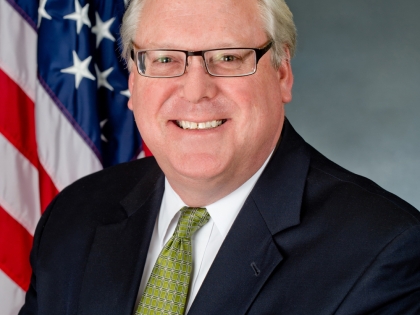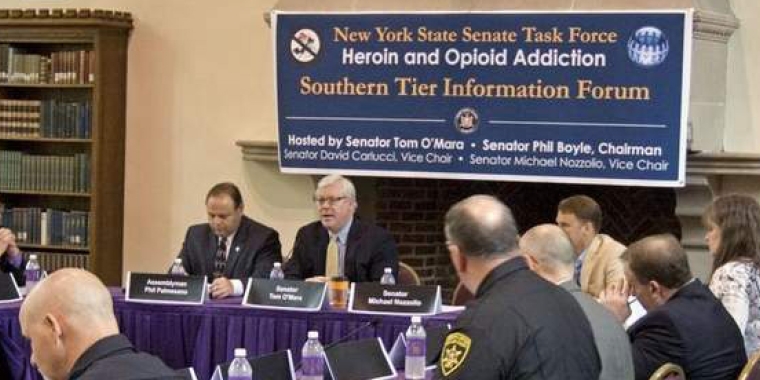
Senate approves anti-heroin legislation to address growing crisis
Thomas F. O'Mara
June 9, 2014
-
ISSUE:
- Controlled Substances

Albany, N.Y., June 9—The New York State Senate today approved a series of legislative initiatives co-sponsored by Senator Tom O'Mara (R,C-Big Flats) aimed at addressing the growing heroin crisis across the Southern Tier and Finger Lakes regions, and statewide.
"We need to act now to save lives. Heroin’s resurgence is a public health and safety crisis that’s putting individual lives and communities at risk. It threatens to overwhelm local systems of health care, social services and criminal justice,” said O’Mara. “The Senate Task Force on Heroin has put forth a meaningful combination of tougher laws and law enforcement, greater public awareness and education, and more effective prevention and treatment strategies. Hopefully the Assembly will follow the Senate and these measures will soon be signed into law by the governor.”
The Senate’s comprehensive anti-heroin legislative strategy was first unveiled two weeks ago by the joint, bipartisan Senate Task Force on Heroin and Opioid Addiction, on which O’Mara serves as a member.
[watch Senator O'Mara's comments HERE]
The task force has held nearly 20 public forums across the state since early April, including one O’Mara sponsored at Elmira College on May 16th. O’Mara and his legislative colleagues have solicited more than 50 hours of testimony from regional law enforcement officers and leaders, drug addiction counselors, treatment providers, educators, social services and mental health professionals, and other experts – as well as recovering addicts -- about the range of complex challenges posed by heroin including addiction prevention and treatment options, drug-related crimes, and other community and public safety impacts.
The Senate hopes to have its proposed, new anti-heroin laws enacted before the scheduled conclusion of the current legislative session next week.
O’Mara said that the Senate’s legislative strategy focuses on a range of actions involving prevention, treatment and stricter criminal penalties. One measure (S.7655), which O’Mara said was highlighted at the Elmira hearing he sponsored by supporters of the Monterey Shock Incarceration Correctional Facility that’s slated for closure by the Cuomo administration later this summer, would direct the state Department of Corrections and Community Supervision (DOCCS) and the state Office of Alcoholism and Substance Abuse Services (OASAS) to study the feasibility of converting closed correctional facilities to provide treatment for substance use disorders. Agencies would examine the feasibility of such centers providing both inpatient residential and outpatient care.
The Senate plan also includes proposals, all of which are co-sponsored by O’Mara, to:
> require OASAS and the state Department of Health (DOH) to establish the “Heroin and Prescription Opioid Pain Medication Addiction Awareness and Education Program.” The program would utilize social and mass media to reduce the stigma associated with drug addiction, while increasing public’s knowledge about the dangers of opioid and heroin abuse, the signs of addiction, and relevant programs and resources (S.7654);
> provide that naloxone kits distributed through an opioid overdose prevention program must include an informational card with instructions on steps to take following administration, as well as information on how to access addiction treatment and support services. Opioid overdose prevention programs provide those at risk of an overdose, their family members and their friends with naloxone kits and training on proper administration (S.7649);
> establish the Opioid Treatment and Hospital Diversion Demonstration Program, requiring the development of a new model of detoxification and transitional services for individuals seeking to recover from opioid addiction that reduces reliance on emergency room services (S.2948);
> improve the utilization review process for determining insurance coverage for substance abuse treatment disorders, and requires insurers to continue to provide coverage throughout the appeals process (S.7662);
> create an A-I felony for the unlawful transportation or sale of an opioid that causes the death of another (S.7657);
> facilitate convictions for operating as a major trafficker by reducing the number of people that must have participated from four to three, and lowering the minimum required proceeds from the sale of controlled substances during a 12-month period from $75,000 to $25,000 (S.7663);
> allow prosecution for a new crime when an individual unlawfully transports an opioid any distance greater than five miles within the state, or from one county to another county within the state, to address diversion and distribution of heroin and prescription drugs (S.7659); and
> provide that possession of 50 or more packages of a Schedule I opium derivative, or possession of $300 or more worth of such drugs, is presumptive evidence of a person’s intent to sell (S.7169).
The full report of the Senate Task Force on Heroin and Opioid Addiction, which will be amended to include additional information from the Elmira hearing and some of the task force’s more recent forums, including a complete listing of proposed legislation, can be viewed HERE.
The bipartisan Senate task force was created earlier this year at a time when local police departments, including many across the Southern Tier and Finger Lakes regions, were pointing to the alarming rise in the availability and use of heroin. According to figures from Cayuga Addiction Recovery Services, the numbers of 19-to-25 year olds in the Southern Tier and Finger Lakes treated for drug abuse increased more than 35 percent from 2007 to 2012.
Share this Article or Press Release
Newsroom
Go to Newsroom


